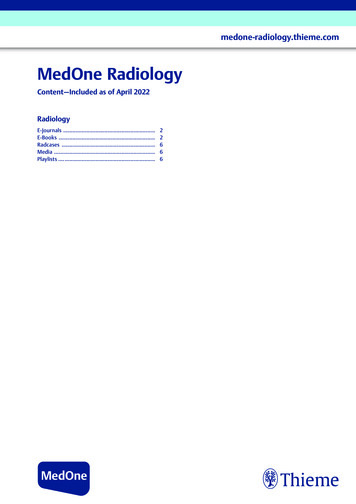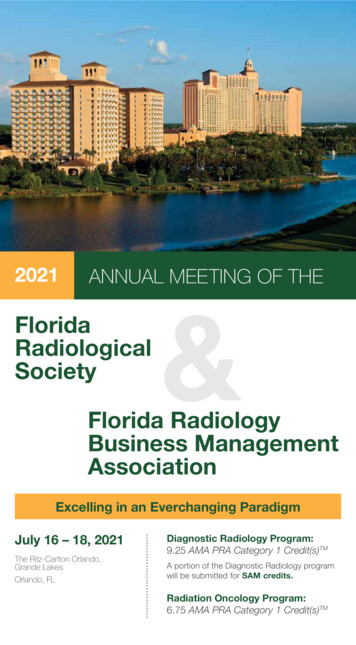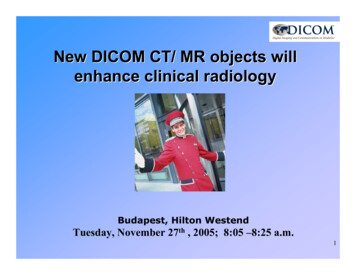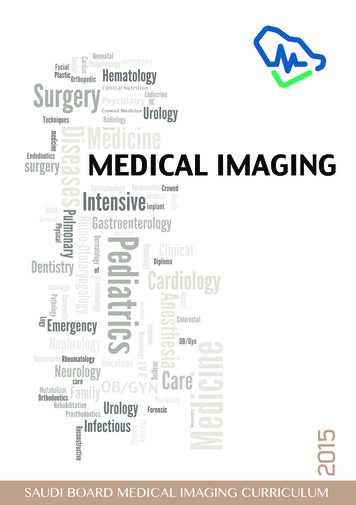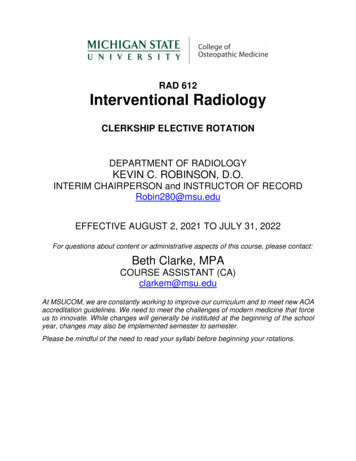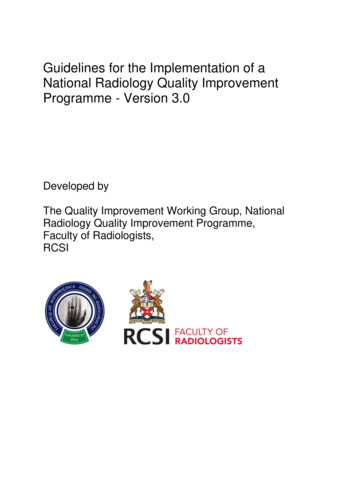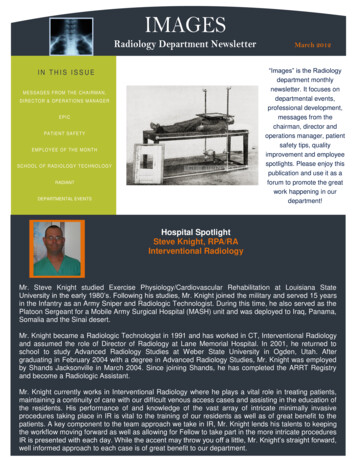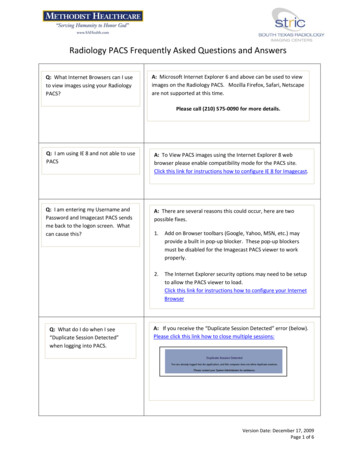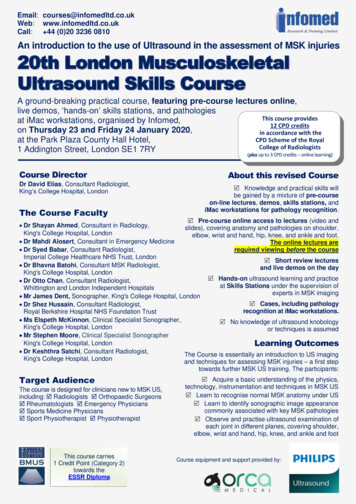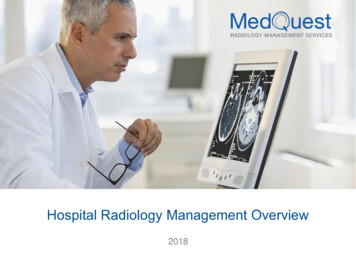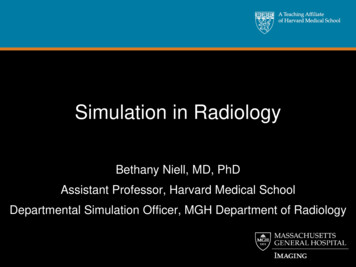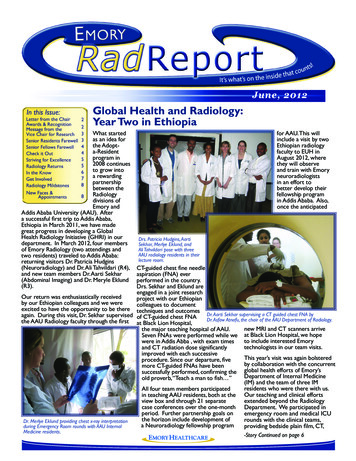
Transcription
1Global Health and Radiology:Year Two in EthiopiaWhat startedas an idea forthe Adopta-Residentprogram in2008 continuesto grow intoa rewardingpartnershipbetween theRadiologydivisions ofEmory andAddis Ababa University (AAU). Aftera successful first trip to Addis Ababa,Ethiopia in March 2011, we have madegreat progress in developing a GlobalHealth Radiology Initiative (GHRI) in ourdepartment. In March 2012, four membersof Emory Radiology (two attendings andtwo residents) traveled to Addis Ababa:returning visitors Dr. Patricia Hudgins(Neuroradiology) and Dr. Ali Tahvildari (R4),and new team members Dr. Aarti Sekhar(Abdominal Imaging) and Dr. Meryle Eklund(R3).for AAU. This willinclude a visit by twoEthiopian radiologyfaculty to EUH inAugust 2012, wherethey will observeand train with Emoryneuroradiologistsin an effort tobetter develop theirfellowship programin Addis Ababa. Also,once the anticipatedDrs. Patricia Hudgins, AartiSekhar, Merlye Eklund, andAli Tahvildari pose with threeAAU radiology residents in theirlecture room.CT-guided chest fine needleaspiration (FNA) everperformed in the country.Drs. Sekhar and Eklund areengaged in a joint researchOur return was enthusiastically receivedproject with our Ethiopianby our Ethiopian colleagues and we werecolleagues to documentexcited to have the opportunity to be there techniques and outcomesDr. Aarti Sekhar supervising a CT guided chest FNA byagain. During this visit, Dr. Sekhar supervised of CT-guided chest FNADr. Asfaw Atnafu, the chair of the AAU Department of Radiology.the AAU Radiology faculty through the first at Black Lion Hospital,new MRI and CT scanners arrivethe major teaching hospital of AAU.Seven FNAs were performed while we at Black Lion Hospital, we hopeto include interested Emorywere in Addis Abba , with exam timestechnologists in our team visits.and CT radiation dose significantlyimproved with each successiveThis year’s visit was again bolsteredprocedure. Since our departure, fiveby collaboration with the concurrentmore CT-guided FNAs have beensuccessfully performed, confirming the global health efforts of Emory’sDepartment of Internal Medicineold proverb, “Teach a man to fish ”(IM) and the team of three IMresidents who were there with us.All four team members participatedin teaching AAU residents, both at the Our teaching and clinical effortsview box and through 21 separateextended beyond the Radiologycase conferences over the one-month Department. We participated inperiod. Further partnership goals onemergency room and medical ICUthe horizon include development ofrounds with the clinical teams,Dr. Merlye Eklund providing chest x-ray interpretationa Neuroradiology fellowship programproviding bedside plain film, CT,during Emergency Room rounds with AAU InternalMedicine residents.-Story Continued on page 6
2LETTER FROM THE CHAIRDear Colleagues,On May 14th the EmoryUniversity campus wasoverrun with the annualthrongs of students, facultyand institutional leadersin colorful academicregalia. Proud familieshurried across the muddyQuad in preparation forthe ceremony to begin.While at first it appearedthat the 34-year record ofrainless Emory graduationswould be shattered, theraindrops subsided justas everyone took theirseats at the start of theprocession. Preceded bysome controversy, renownedJohns Hopkins neurosurgeonand humanitarian BenCarson was an inspiringkeynote speaker. (I recallmy own sense of awe as aneuroradiology fellow atHopkins when comparingpre and post-operative brainMRIs taken on a patientof Dr. Carson; the onlydifference from the first tothe latter scan seemed tobe disappearance of a largetumor with no obvioustrauma to the surroundingtissues). Among otherspecial moments was whenour own faculty memberMalgorzata Lipowska hadthe honor of “hooding”her daughter as part of theSchool of Medicine diplomaceremony.Shortly to follow thefinishing medical studentsand medical imagingtechnology students,our senior residents andfellows will be embarkingon the next phase of theircareers in just a few weeks.Preparing our best andbrightest for the future is anincreasingly challenging task.The exponentially risingrate of change in technologyand health care makes whatconstitutes “best practice”an ever-evolving matter.More and more, we tailorteaching to include theskills of how to learn andassimilate new knowledgerather than simply passingon a seriesof facts andspecificskills. At theASNR’s 50thAnniversarymeetinglast month,my mentorR. Nick Bryan, M.D.,Ph.D., recalled thatessentially none of theprocedures and diagnosticexaminations included inhis own neuroradiologyfellowship remain a partof neuroradiology practicetoday. Indeed, learning islifelong and never complete.Best to all,Carolyn C. Meltzer, MD, FACRChair of Radiology and Imaging SciencesAWARDS & RECOGNITIONDeborah Baumgarten,MD, MPH, FACRProfessor of RadiologyAssociate Program Director,Diagnostic Radiology ResidencyEmory MagazineSpring 2012Dr. Baumgarten was recognized in theSpring 2012 issue of the Emory Magazine forher eco-friendly lifestyle and taking sustainableliving to the next level. Dr. Baumgarten and herhusband share a zero-emissions vehicle; theyalso have an electric scooter as backup. They’vereplaced light bulbs with LEDs; recycle, reuse,or compost as much as possible; and eat local,organic, and mostly produce—no meat, pork, orchicken. She and her husband are in the processof designing a green home for her family.LaSonya Barnes,Senior Medical AssistantSusan Reeder, RT, RDMSEUHM- UltrasoundBachelors of ScienceSusan received her BS degree in Healthcare Managementfrom the University of St. Francis where she was honoredwith the Dean’s Scholar award. Susan will be attendingthe Emory Healthcare Quality Academy: Practical Methodsfor Healthcare Improvement this Fall and Emory’s Six Sigma Program inthe spring. She is a member of the Service Excellence Committee and afacilitator of the Service Excellence Institute.John Holbrook, MDAssistant ProfessorEmory Johns Creek’s Interdisciplinary TeamAwardDr. Holbrook was one of two people at Emory JohnsCreek Hospital to win the Interdisciplinary Team Award“for outstanding performance and lasting contribution.” The award waspresented to Dr. Holbrook by the Nurses Week Planning Committee.EUH-Cardiac CTSchool at Work ProgramLaSonya Barnes recently graduated from the SAW (School At Work) Program on May 3, 2012. SAW is anemployee-centered, distance learning system. The program connects highly motivated and qualified EmoryHealthcare employees in entry-level positions to the education process, and job advancement opportunities thatmay become available with increased education and career planning.
3MESSAGE FROM THE VICE CHAIR FOR RESEARCHOne of the themes of my column has been to make it as easy as possible for people to get started in research. One particularchallenge is making potential researchers aware of established investigators who would like their help. Another challenge is havingan appropriate venue for investigators to advertise their projects and solicit help. Dr. Jon Nye and Nivedita Raghunath havedeveloped an online database to help make these connections. See the description below and thank Jon and Niv when you get achance.- John Votaw, PhD, Vice Chair for ResearchConnections to Make Research HappenThe Radiology and Imaging SciencesResearch Database (RIMS) is awebsite built to match researchersengaged in clinical, translationaland basic science research withmotivated residents and studentsinterested in gaining researchexperience. Jonathon A. Nye, PhDand Nivedita Raghunath MS from theEmory’s Center for Systems Imaging(CSI) in collaboration with Dr. JohnVotaw,Vice Chair for Research,and Dr. Mark Mullins,Vice Chairfor Education developed the RIMStool to foster research exchangesbetween Department faculty,residents and students.The website .html) receives submissionsof focused or hypothesisdriven research projectsfrom Department faculty andcatalogues these projects sothat they can be searched andviewed by residents and students.Residents and students who areinterested in a project can thencontact the faculty mentor andsign up through the website. Thegoal of the website is to promotementor-mentee relationships thatwill enhance the productivityof the mentor and establish aresearch track record for the mentee For example,the website could assist research faculty seeking theclinical reading expertise of a radiology fellow forhuman imaging trials or provide training to a residentwho wishes to develop quantification skills that arenot yet practiced clinically.For research interests that are not represented by anactive project in the database, residents or studentscan fill out a profile describing their interests. Theseprofiles can then be viewed by faculty mentors whowish to develop a research relationship.RIMS is designed to be a dynamic resource for thementor and mentee. The database tool can trackparticipants and the progress of their research. Forexample, residents who sign up for a project arelisted with that project and can view others involved.In addition, presentations and published work suchas abstracts, case reports and journal articles canbe recorded in the database. These aspects of thewebsite can be managed by the faculty mentor orthrough a proxy such as another researcher, resident,or administrative assistant.RIMS can be accessed through the CSI core websiteat the following address dex.html. Please log on andview the active projects and think about how youcan become involved in research with our faculty,residents and students.Above is the Homepage of the RIMS research database. From here, users can search currentprojects, submit a new project and manage requests from faculty, residents and students.- Jon Nye, PhDAssistant ProfessorSENIOR RADIOLOGY RESIDENTSThe following residents will be completing their residency program in June and either continuing their training in a fellowshipprogram or beginning practice. This has been an excellent group of residents and we wish them well in their new endeavors. Weare fortunate that many of them will remain in the department for at least another year.John Chenevey, MDContinuing at Emoryin Body MRI FellowshipLiang “Sean” Gu, MDContinuing at Emoryin MusculoskeletalChester Harrison, MD, MSContinuing at Emoryin Nuclear MedicineKeith Herr, MDContinuing at The Universityof California, San Franciscoin Abdominal ImagingAjay Kamireddi, MDContinuing at CornellUniversity in Body/MRIMichael Lubarsky, MDContinuing at Emoryin NeuroradiologyMatthew Lynn, MDBhavika Patel, MDBrad Mitchell, MDSarat Mallik Piduru, MDElizabeth Parker, MDAli Tahvildari, MDContinuing at Emory inPediatric RadiologyContinuing at Emoryin NeuroradiologyContinuing at Emoryin MusculoskeletalContinuing at Emoryin Breast ImagingContinuing at Emoryin Interventional RadiologyContinuing at StanfordUniversity in Body ImagingDaymen Tuscano, MDContinuing at Emoryin Breast Imaging
4SENIOR RADIOLOGY FELLOWSThe following fellows will be completing their program in June. We have included their future plans and wish them greatsuccess in their Radiology careers.Adam Abou-Elias, MDCompleted his Fellowship and willcontinue his career in the field ofradiologyMarianne Mullin Ballisty, MDJoining Asheville Radiology Associates– Asheville, North CarolinaMichael Collins, MDJoining Radiology Associates of ColumbiaMark Dannenbaum, MDContinuing at The University of TexasHouston Health Science Center– Houston, TexasTarek Hanna, MDJoining Hanna Radiology AssociatesVirtual Radiology ProfessionalsJames Hart, MDCompleted his Fellowship and willcontinue his career in the field ofradiologyRyan Polselli, MDJoining Atlantic Radiology Associates– Savannah, GeorgiaDarren Kies, MDContinuing at Emory UniversityInterventional Radiology FellowshipJustin Rafael, MDJoining Radiology Associates of SouthFlorida Baptist Health– South FloridaDouglas Lukins, MDJoining the University of Kentucky inNeuroradiologyHemali Desai, MBBSCompleted his Fellowship and willcontinue his career in the field ofradiologyKiran Maddu, MBBS, MDContinuing at Emory University withan Emergency Radiology FellowshipThomas Fahrbach, MDJoining University of Kansas Hospital– Kansas City, KansasIan Fischer, MDCompleted his Fellowship and willcontinue his career in the field ofradiologyMatthew Ford, DOContinuing at Hillcrest Medical Center– Tulsa, OklahomaGregg Franco, MDCompleted his Fellowship and willcontinue his career in the field ofradiologyCHECK IT OUTAruna Polsani, MDContinuing at Emory University inNuclear Medicine ResearchHana Khan, MDCompleted her Fellowship and will bejoining a private practiceAbhijit Datir, MBBSContinuing at Emory University withan MSK FellowshipS. Ramisa Ehsan, MBBSCompleted his Fellowship and willcontinue his career in the field ofradiologySachin Parikh, MDJoining Houston Progressive RadiologyAssociates– Houston, TexasMichael Markovic, MDJoining Radiology Associates ofCanton– Canton, OhioJoanna Rossi, MDAllegheny Radiology Asscociates– Pittsburgh, PennsylvaniaHamilton Reavey, MDContinuing at Emory University inNuclear Radiology FellowshipEdward Richer, MDJoining the University of KentuckySadhna Nandwana, MDJoining Emory RadiologyAbdominal DivisionAdeel Sabir, MBBSCompleted his Fellowship and willjoining Sanford Medical Center– Sioux Falls, South DakotaNimesh Patel, MDJoining Advocate Health Care– Park Ridge, IllinoisSabrina Talbott, MDPracticing at Sheridan Radiology– Sunrise, FloridaSanjit Peter, MDCompleted his Fellowship and willcontinue his career in the field ofradiologyAbdul-Rahman Tarabishy, MBBSContinuing at West Virginia University– Morgantown, West VirginiaHasmukh Prajapati, MDContinuing at Emory University withan Interventional Radiology FellowshipKeith Tomich, MDJoining SE Kaiser PermanenteMedical Group of AtlantaGeorge “Croft” Stone, MDJoining Piedmont Newnan Hospitals– Atlanta, GeorgiaKhosa F, Warraich H, Khan A, Mahmood F, Markson L, Clouse ME, Manning WJ. Prevalence of non-cardiac pathology onclinical transthoracic echocardiography. J Am Soc Echocardiogr. 2012 May;25(5):553-7. Epub 2012 Mar 8. Editorial CommentAkbari, H and Fei, B, 3D ultrasound image segmentation using wavelet support vector machines, Medical Physics.Vol. 39, No.6, PP. 2972-2984, June 2012.
5STRIVING FOR EXCELLENCEA Culture of Service ExcellenceWhat a year we have had so far.There have been so many excitingevents that have occurred within thelast six months. There is a strongmove for transparency within ourorganization that is about encouragingcommunication with our leadersand staff – from the “CEO’s Forum”with John Fox, on to the “RadiologyTown Hall: Open Mic” forum withour Department’s leaders. This helpsus to understand why things are theway they are and how we can all makethem better. Having an open andhonest dialogue helps build a cultureof customer service where employeesunderstand that excellent customerservice is not an event but just theway things should be done.By now, everyone in Radiology shouldhave completed two sessions of ourService Excellence Institute (SEI).That is a major accomplishment inand of itself considering over 800Radiology faculty, staff and traineesattended. Our department has evenhad inquiries from other departmentsabout conducting a similar initiative. Ihad the pleasure of presenting at SEIand the amount of positive feedbackthat was received was phenomenal.This is evidence that our staff is trulyconcerned about the future of ourdepartment.As we move forward with sustaininga culture of service excellence, wemust understand that this is a journeythat will continue to evolve. Let’s takea look at three components that wemust preserve to maintain a culture ofservice excellence:1. Leadership ResponsibilityLeadership is about responsibility,not power. First and foremost,our leaders must lead by example.Leaders have the responsibilityof ensuring that our ServiceExcellence Standards are beingupheld by everyone in ourorganization, regardless of the roleor position.2. Employee EngagementIn our SEI sessions,we learned that mostemployees are passivelyengaged. How canwe move to beingRADIOLOGY RETURNSactively engaged? We must bewilling to not be content with thestatus quo. Everyone must takean active part in making sure weare taking care of each other andultimately our patients.3. AccountabilityWe must hold each otheraccountable for our actions.When it comes to upholdingThe Pledge and creating anenvironment of respect, we mustbe able to communicate witheach other when things are outof line. We must be willing tolook at situations from a differentperspective. An unknown authoronce said, “When you change theway you look at things, the thingsyou look at change”.Although we will continue to strivefor perfection, I am willing to settle forexcellence! We have done a great jobthus far. Let us continue to raise thebar and truly make this a destinationdepartment; not only for our patientsbut for ourselves as well!-Willie ArnoldSenior Manager, Clinic Operations60th Annual Meeting of the Association of University RadiologistsUpon first visiting San Antonio, Texas, it apparently isde rigueur to pay one’s respects to the Alamo and tread thesacred soil stained by our brave patriots. I had the opportunityto visit San Antonio for the first time this past March, as amember of Emory’s delegation to the 60th Annual Meeting ofthe Association of University Radiologists (AUR). While therugged hill country setting had its charms, the real attractionwas the gathering itself, which at its heart was a celebration ofacademic radiology. Faculty radiologists eagerly caught up withold friends and colleagues, seeking counsel and collaboration;residents debuted at the podium, presenting papers or exhibits.Emory’s representation at this year’s AUR meeting wasespecially prominent. No fewer than three of our faculty –Mark Mullins, MD, PhD; Kimberly Applegate, MD, MS; anddepartment chair Carolyn Meltzer, MD – served on the2011-2012 AUR Board of Directors.Second-year resident Peter Harri, MD, attended theSiemens-AUR Radiology Resident Academic DevelopmentProgram (SARRAD), held in conjunction with theAUR meeting. Chief Resident Emeritus Keith Herr, MD,moderated a panel discussion of the American Allianceof Academic Chief Residents in Radiology (A3CR2). As newA3CR2 members, Todd Cramer, MD, MPH, and I participatedin problem-solving sessions and swapped stories with fellowchiefs from other programs. Everyone enjoyed the PhilipsVydareny Imaging Interpretation Competition, largely becauseof the verve with which our faculty debated the cases.Not only residents and faculty but also our capableadministrative staff were represented, led by Tammi TeetersMcDade as this year’s President of the Association of ProgramCoordinators in Radiology.Without question the pinnacle of the meeting was the honorgiven to Cardiothoracic Imaging faculty member Stefan Tigges,MD, recipient of the 2012 Outstanding Teacher Award. Dr.Tigges was recognized for his exemplary, inventiveefforts in educating medical students and residents.From my perspective, the AUR meeting was aspectacular success on every front – except one.Fortunately, there were postcards of the Alamo in thehotel gift shop.- Lilli Ivansco, MD, MPH, Radiology Resident, PGY-3
6IN THE KNOWQuality CornerQuality in Health Care is a Race without a Finish LineThe Emory Healthcare qualitypromise to our patients is toprovide impeccable clinicaloutcomes, delivered safely withoutstanding service. To fulfillour promise, we recognizethe importance of settingspecific goals and selecting andprioritizing activities and projectsthat are aligned with EHC’smission and objectives, and aredriven by data, benchmarks andbest practices. Achievement ofthese goals requires not onlymeaningful metrics but alsoimprovement skills and toolsand a supportive and alignedworkplace culture.Health care reform is at theforefront of national news on adaily basis. As providers, one partof this reform is to ensure thatour standards are consistentlykept at the highest possible levels,in order to give excellent careand the best clinical outcomesto our patients. Continuousimprovement means just that: weNEVER stop improving, and weare ALWAYS open to new ideasfrom any source. Improvement isa race without a finish line. Thatshouldn’t be frightening. It’s quitesimply just a matter of visualizingcontinuous improvement as away to better serve our patients.Quality in health careencompasses many differentfacets, including: medicationreconciliation, mortality andincident rate, reduction, riskmanagement, core measures,patient safety, qualitymanagement, and qualityimprovement. Patient safety andcost efficiency initiatives providean opportunity for EmoryHealthcare to make a positivedifference on society whilepromoting ourvision and contributing tothe financial success of ourorganization.According to a report from theOffice of Inspector General inthe United States Department ofHealth and Human Services, weare entering a new era of thinkingabout health care quality andcollaboration among health careproviders. Many new measures ofhealth care quality are becomingpublic every day. Purchasers,payors, state governments, theJoint Commission, and others arerequiring reporting, particularlyby hospitals, of outcomespursuant to such measures. Payfor-performance programs arebecoming common among boththe public and private payors.We can no longer live by the rule“if it isn’t broke, don’t fix it”. Intoday’s health care environment,‘sameness’ is the fast track tomediocrity. Like the innovators ofour past, we must continuouslylook for ways to do things betterand make changes in the interestof improving patient outcomes.Change is inevitable. In hisacclaimed book “Who MovedMy Cheese?”, author SpencerJohnson’s character Haw, themouse, reflects on his journeyby leaving a message for othersafter learning the hard way thatchange happens; that you mustanticipate, monitor, and adaptto change quickly; and above all,enjoy change.Every member of the RadiologyDepartment is an integral partof the race for innovation. Weare empowered to make changehappen. We are encouragedto look for ways to do thingsbetter within our department.And we must openly and freelycollaborate with others to giveour patients the best clinicaloutcomes and ensure safety. BeEmory.So ladies and gentleman . startyour engines!- Susan Reeder, RT, RDMSSonographer Emory Midtown- Global Health and Radiology: Year Two in Ethiopia continued from page 1rounds with the clinical teams,providing bedside plain film, CT, andMR interpretations on hard-copyfilms, which would otherwise nevermake it to the Radiology Department.In Ethiopia, there is no film archivalsystem and patients keep all hard-copyfilms (including prior films and outsidestudies) with them. These films oftenare interpreted bedside by a nonradiologist.Through the strong support of ourdepartment, including Dr. CarolynMeltzer and Dr. Mark Mullins, ourGlobal Health Radiology Initiative (toinvolve radiology residents in globalhealth work) and our partnership withAAU continues to build and grow. Now,with support from Dean Lawley forGlobal Health partnerships across allSchool of Medicine departments, EmorySOM has started the Global HealthResidency Scholars Program (GHRSP),which will provide further fundingfor our residents. For the 2012-2013academic year, three radiology residentshave been accepted into the GHRSP:Drs. Andrew Lemmon (R3), Annie Gill(R2) and Ryan Peterson (R2).Through the success of this partnership,which is fairly unique in the field ofRadiology, we hope to encourageinternational volunteerism byradiologists in training and in practiceand bridge the gap between radiologyand medical humanitarianism.- Ali Tahvildari, MDRadiology Resident, R4
7GET INVOLVEDSEI – Top Three PrioritiesThe results are in from the survey toestablish our Top Three Priorities forimproving the experience of our Patientsand their families. The department-widesurvey offered 12 actionable optionsthat were suggested by members ofour department during the ServiceExcellence Institute (SEI) Session I. Thetop three priorities, as established by ourfaculty and staff are: Calling/texting patients Pre-Posttheir procedure to ensure thatthey are prepared when theyarrive and we can address anyquestions they may have aftertheir procedure. Develop a Kiosk/iPad App forSelf Check-in Patient Tracking Board forfamiliesus to identify potential strengths andweaknesses, and ultimately develop awell rounded solution and approachto implementation. Following thebrainstorming session, we will have asign-up sheet for those who wouldlike to stay involved on the projectcommittee to see the initiativethrough to implementation. We arelooking for actively engaged membersfor each of the initiatives and stronglyencourage you to choose one topicto get involved, so that you dedicateyour focus to one area.The leadership panel for the first Hummus with HabibWhile we have established the topaddress questions and suggestions from all ares of ourthree priorities, this does not mean department. (Left to right) Mike Armstrong, Dale Walker,Dr. Carolyn Meltzer, Dr. John Votaw and Habib Tannir.that we will not explore the othersuggestions made. This is simply ato participate.starting point for our department. WithOne of the common comments fromyour help of setting these prioritiesthe SEI Sessions was that peoplewe can manageably work towardsenjoyed having a chance to interactimprovement, instead of trying to dowith our leadership. In an effort toYou can get involved with these initiatives everything at one time. If you did notinclude this highlight in our Serviceby participating in brainstorming sessions see your idea on the survey, this couldExcellence Culture and enhance ourmean that there are plans to developwe will be holding for each of thesework environment, you can look forwardyour idea at an organizational level ortopics in July. During these sessions weto participating in our quarterly townthat a departmental committee is already hall style meetings, Radiology Town Hall:will welcome all perspectives and ideas.developing this measure to improve theStarting the projects this way will helpOpen Mic. Our first Towh Hall was heldpatient experience. One example ison May 25 with 110 attendees across allthe Patient Passport, which is already the sites.being developed by the ServiceExcellence Committee (SEC).As we embrace this new culture welook forward to your participation inIn addition to these three initiatives,whatever way you to choose to bewe will perpetuate the Serviceactively engaged. For many of you thisExcellence Culture by offeringmay be exemplifying a change in yourvoluntary courses on topics thatarea. For others it may be participating inwere suggested during the SEIa committee. The way you identify withSessions. A few of the topics that you Service Excellence and get involved withcan look forward to being offeredmoving our culture forward is up to you,are Cultural Diversity, Teamwork,and please know that your efforts areSelective Hiring and Communicationappreciated. As we take our service levelwith DiSC. These offerings will beup a notch, we will all benefit from theDr. Carolyn Meltzer and Habib Tannir, lead theposted at least one month in advance. effort made by each person.presentation, and listen to the faculty and staffs concernsPlease remember to request the timeduring SEI II.- Monica Salama, Communications ManagerDo you deliver Service Excellence?Quizzes are still being conducted by leadership. The goal of the SEI quiz is to give everyone a chance to showthat he/she is working towards Service Excellence. To accomplish this goal you will be given a two-questionpop quiz. The answer to the first question can be found on your SEI badge cards. The second question willchallenge your knowledge of SEI concepts. If both questions are answered correctly, you will receive a pin(safe to wear in MR areas) that states, “I Deliver Service Excellence.” If you are unable to answer bothquestions correctly, you will be given a second chance at a later time.Make sure to review the material that was given to you in Session I and also reference past SEI emails torefresh your knowledge of SEI concepts. Our goal is for every member of the Department of Radiology and Imaging Sciencesto earn a Service Excellence pin. These pins are a visual representation of our Department working towards the goal of ServiceExcellence.
8RADIOLOGY MILESTONESMedical Imaging Program GraduationOn May 14, 2012, 24 Emory Graduates celebrated as they received theirBachelor’s Degree in Medical Imaging. Kim Landmon was the graduationspeaker and addressed the students about being “In the Moment”.Through the Emory Medical Imaging Program, aspiring RadiologicTechnologists (RT), along with practicing RTs, are given the opportunityto specialize their skills as an RT in the areas of CT, MR, IR, educationor administration. This year, twelve graduates completed their programwith a focus in MR, four in CT, two in IR, one in education and five inadministration.Student Awards Valedictorian:Ashlyn BiermanOutstanding Clinical Student:Ashlyn BiermanColleague Award:Ashlyn BiermanMost Improved Clinical Student:Michelle MurdockJRCERT Student Award of Excellence: Brandi BaldwinClinical Awards Clinical Site of the Year:The Emory Clinic - Winship Cancer InstituteOutstanding Technologist Educator:Pat Kimbell - ExecutivePark Orthopaedic andSpine CenterRookie TechnologistEducator:Ben Smith - PRN EmoryHealthcareJRCERT EducatorAward of ExcellenceEmily Castillo - formerlyof Emory UniversityHospital – Clifton CampusWeek of June 4, 2012Wed., June 6 –NO Grand Rounds Summer BreakThurs., June 7 –Research In Progress Series (RIPS)NO RIPSWeek of June 11, 2012Thurs., June 14 –Research In Progress Series (RIPS)Zhongxing Liang, PhDInvolvement of miR-302 inbreast cancer radioresis
Emory and Addis Ababa University (AAU). After a successful first trip to Addis Ababa, Ethiopia in March 2011, we have made great progress in developing a Global Health Radiology Initiative (GHRI) in our department. In March 2012, four members of Emory Radiology (two attendings and two residents) traveled to Addis Ababa:
